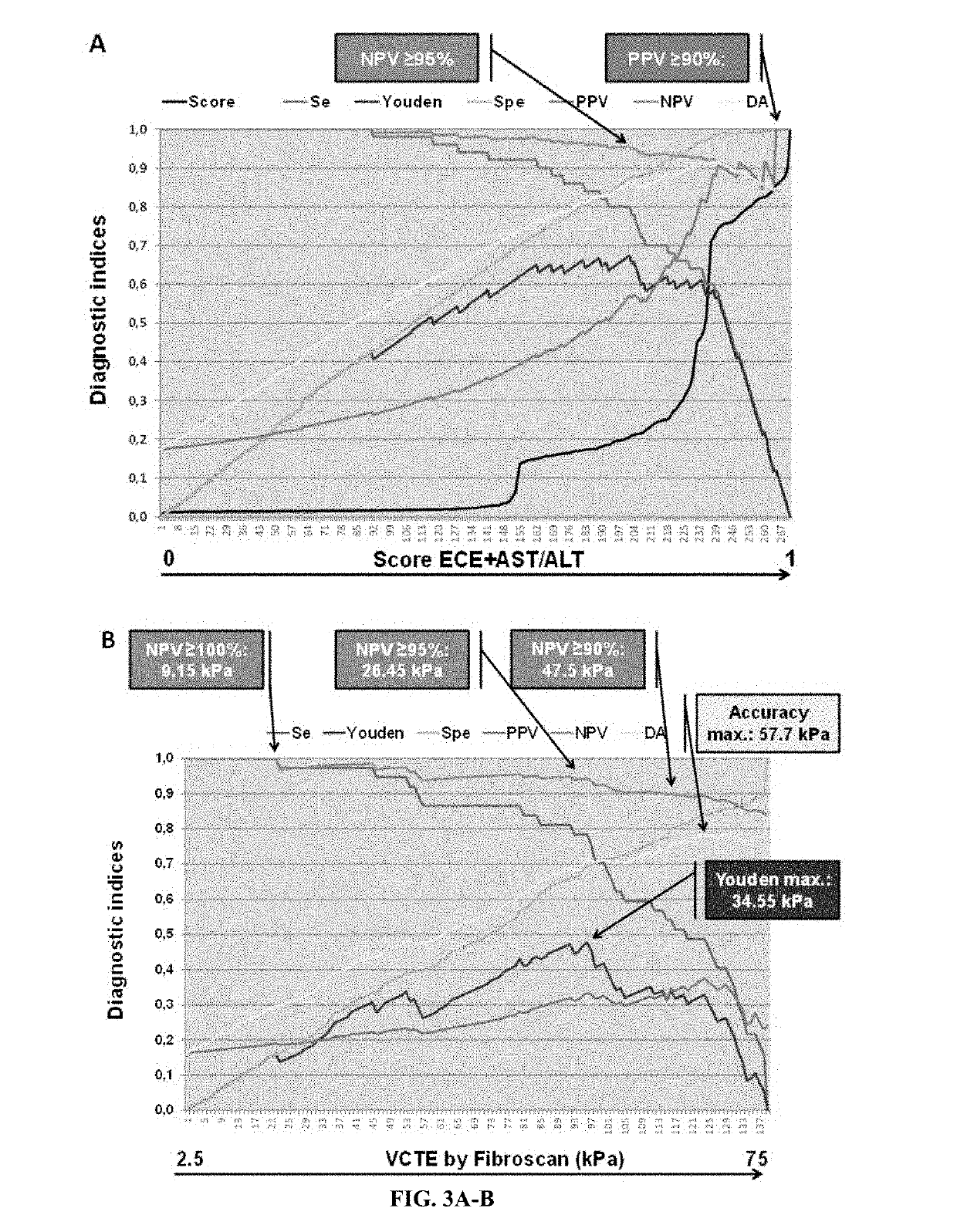Non-invasive method for assessing the presence and severity of esophageal varices
a non-invasive, esophageal varices technology, applied in the field of assessment of the presence and/or severity of varices, can solve the problems of poor acceptance by patients, major cause of mortality and economic burden, and limited esophageal varices, so as to reduce the number of missed esophageal varices
- Summary
- Abstract
- Description
- Claims
- Application Information
AI Technical Summary
Benefits of technology
Problems solved by technology
Method used
Image
Examples
example 1
Patients and Methods
Patient Populations
[0467]Diagnostic strategy development needed a derivation population where all diagnostic tests were available, especially esophageal capsule endoscopy (ECE). For that purpose, we disposed of a population with cirrhotic patients. The derivation population was extracted from a prospective study comparing ECE and upper gastro-intestinal endoscopy (UGIE) in the esophageal varices (EV) diagnosis in patients with cirrhosis with various causes (Sacher-Huvelin S, et al, Endoscopy 2015: (in press: PMID: 25730284)). We included the 287 patients having both ECE and UGIE.
[0468]Validation populations were already published for the evaluation of non-invasive fibrosis tests (except population #4). The two main differences with derivation population were (i) the availability of liver biopsy in all patients and (ii) that all fibrosis stages were represented.
[0469]Validation of diagnostic strategy required a chronic liver disease (CLD) population with UGIE for ...
example 2
Evaluation and Improvement of Baveno 6 Recommendation for Non-Invasive Diagnosis of Esophageal Varices
Introduction
[0511]Screening for esophageal varices (EV) is recommended in cirrhosis. The Baveno6 recommendations allow ruling out EV if platelets >150 G / l and Fibroscan <20 kPa. However, primary prevention focuses on large EV (LEV) and it is unknown in which etiology this rule applies. Therefore, we evaluated this rule and tried to improve it with the aim of 100% predictive values (NPV, PPV).
Methods
[0512]287 patients with cirrhosis of various causes were prospectively included. Diagnostic tools were UGI endoscopy, 16 blood fibrosis tests, and Fibroscan. Patient characteristics were: men: 72%, age: 55+11 years, causes: alcohol: 64%, virus: 26%, NAFLD: 6%, others: 4%; EV: none: 56%, small: 27%, large: 17%.
Results
[0513]Evaluation: NPV of Baveno6 rule was: EV: 87.1%, LEV: 100%. The spared endoscopy rate was only 16.4%. This rate was 38% with the best performing blood test (CirrhoMeter (...
example 3
phageal Varice Screening with a Cirrhosis Blood Test Alone or Combined with Capsule Endoscopy in Chronic Liver Diseases
[0517]The conventional management of patients with suspected liver cirrhosis suffers from several limitations. First, several surveys [5] have reported that LEV screening policies based on UGIE are not well applied, which is probably attributable to the aforementioned constraints encountered by physicians in real-life clinical practice. Second, classical liver biopsy cannot be easily repeated; this may allow asymptomatic cirrhosis to go undetected, only to be revealed later by the development of complications. Therefore, improving the non-invasive diagnosis of cirrhosis is indeed an attractive option, but this too has limits and implications. First, an earlier diagnosis introduces a risk of UGIE overuse (FIG. 8). Indeed, recent guidelines stated that “HCV patients who were diagnosed with cirrhosis based on non-invasive diagnosis should undergo screening for PHT” [6]...
PUM
| Property | Measurement | Unit |
|---|---|---|
| pressure | aaaaa | aaaaa |
| pressure | aaaaa | aaaaa |
| pressure | aaaaa | aaaaa |
Abstract
Description
Claims
Application Information
 Login to View More
Login to View More - R&D
- Intellectual Property
- Life Sciences
- Materials
- Tech Scout
- Unparalleled Data Quality
- Higher Quality Content
- 60% Fewer Hallucinations
Browse by: Latest US Patents, China's latest patents, Technical Efficacy Thesaurus, Application Domain, Technology Topic, Popular Technical Reports.
© 2025 PatSnap. All rights reserved.Legal|Privacy policy|Modern Slavery Act Transparency Statement|Sitemap|About US| Contact US: help@patsnap.com



